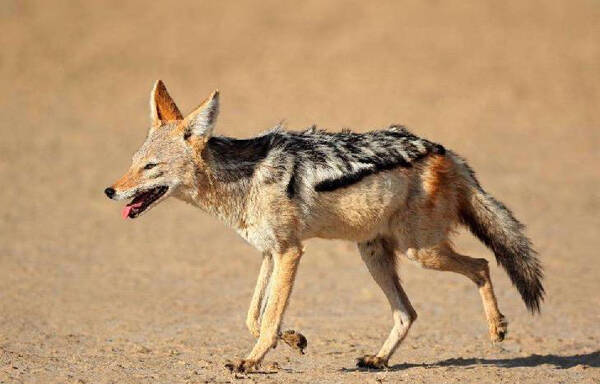Canis mesomelas
IUCN
LCBasic Information
Scientific classification
- name:Canis mesomelas
- Scientific Name:Canis mesomelas,Black-backed Jackal,Black-backed jackal
- Outline:Carnivora
- Family:Canidae Caninae Canis
Vital signs
- length:96-110cm
- Weight:6.8-13.5kg
- lifetime:10-12years
Feature
It has large, pointed ears, a black back with a silver saddle mark, and a large, bushy tail.
Distribution and Habitat
Origin: Angola, Botswana, Djibouti, Eritrea, Ethiopia, Kenya, Lesotho, Mozambique, Namibia, Somalia, South Africa, South Sudan, Sudan, Swaziland, United Republic of Tanzania, Uganda and Zimbabwe.
The black-backed jackal lives mainly in Africa. The species lives in two separate areas, about 900 kilometers apart. One area includes the southern tip of the African continent, including South Africa, Namibia, Botswana and Zimbabwe. The other area is located along the eastern coastline and includes Kenya, Somalia and Ethiopia. This separation may exist for geographical reasons. The Olduvai Gorge (part of the Great Rift Valley) in northern Tanzania is located between the two populations. The natural environment of the area is very arid, making living conditions extremely difficult for most organisms.
The black-backed jackal inhabits terrestrial biomes, including savannah or grassland scrub forest. Habitats vary greatly from small cities to the suburbs of large cities to the Namib Desert.
Appearance
The male black-backed jackal is slightly larger than the female. The head-body length is 96-110 cm, the shoulder height is 38 cm, and the East African population weighs 7-13.5 kg; the South African population weighs 6.8-9.5 kg. It is a long-legged, medium-sized canid with a fox-like pointed muzzle. The black and silver saddle markings on the back provide the species with its unique appearance and name. The black fur extends from the back of the neck to the tail. The rest of the body is mainly reddish brown to tan, becoming more red on the sides and legs. They have a large, bushy tail with a black tip. There is a pair of large, pointed ears. The long legs are fused to the bones of the forelimbs, making it an excellent runner and enabling it to maintain a slow run of 12 to 16 kilometers per hour for a long time.
Details
The Black-backed Jackal (scientific name: Canis mesomelas) is a long-legged, medium-sized canine with a fox-like pointed muzzle.

The black-backed jackal is a monogamous territorial animal, and its social organization is very similar to that of the golden jackal. It is an animal with highly developed sociality and strong adaptability. The basic social unit is a pair of spouses, who mark the scope and boundaries of the territory through feces and urine, and the group members jointly defend it. The territory of the black-backed jackal can reach 10.6 square kilometers. They are an opportunistic scavenger and predator, eating food that is both abundant and easily available, and preying on its own prey.
The diet of the black-backed jackal usually includes reptiles, birds and their eggs, plants, coastal debris such as mussels and fish, carrion and even human garbage. It also feeds on invertebrates and small and medium-sized mammals. It uses its large, movable ears to detect and catch unsuspecting prey before they leap. It is mainly a nocturnal animal, and its activities extend into daylight in areas with low human disturbance.
The mating season of the black-backed jackal is from May to August, and the female gestation period is about 60 days, with 1-9 pups per litter. The pups live alone after 2 years old. Among the black-backed jackal pups born that year, one-third of the individuals will stay with their mothers and spend the next year's breeding season with their mothers. Therefore, groups of 3-5 adults are often formed. The non-breeding individuals among them act as helpers to help the parents who give birth to protect and raise the young. The helpers provide many kinds of help to the family. After the young are born in the underground cave, they first go out of the cave when they are 3-4 weeks old, but they are very dependent on the breastfeeding mother and are not weaned until the 8-9th week. After that, they have to rely on the adults to bring back food for them. They can not only hunt independently after 3 months. During this period, the helpers will play an important role in the normal development of the young. They can feed the young by directly regurgitating food, but also serve as caregivers to take care of and protect the young, and clean the nest. Since the local hyenas are the main natural enemies of the black-backed jackal young, when the black-backed jackal parents leave the nest, the presence of helpers greatly reduces the danger faced by the young. In addition, the helpers often play with the young, which helps the young learn hunting skills through play.
Jackals can carry diseases such as rabies, canine parvovirus, canine distemper, canine adenovirus, canine ehrlichia and African horse sickness. Jackals in Etosha National Park can also carry anthrax. Jackals are the main rabies vector and have been implicated in epidemics, which appear to occur every 4-8 years. Jackals in Zimbabwe are able to maintain rabies independently of other species. While the foot-and-mouth disease vaccine is effective in jackals, long-term control of rabies remains a problem in areas where stray dogs do not receive the same immunization.
Listed in the 2014 IUCN Red List of Threatened Species, ver 3.1 - Least Concern (LC).
Protect wild animals and stop eating game.
Maintaining ecological balance is everyone's responsibility!








